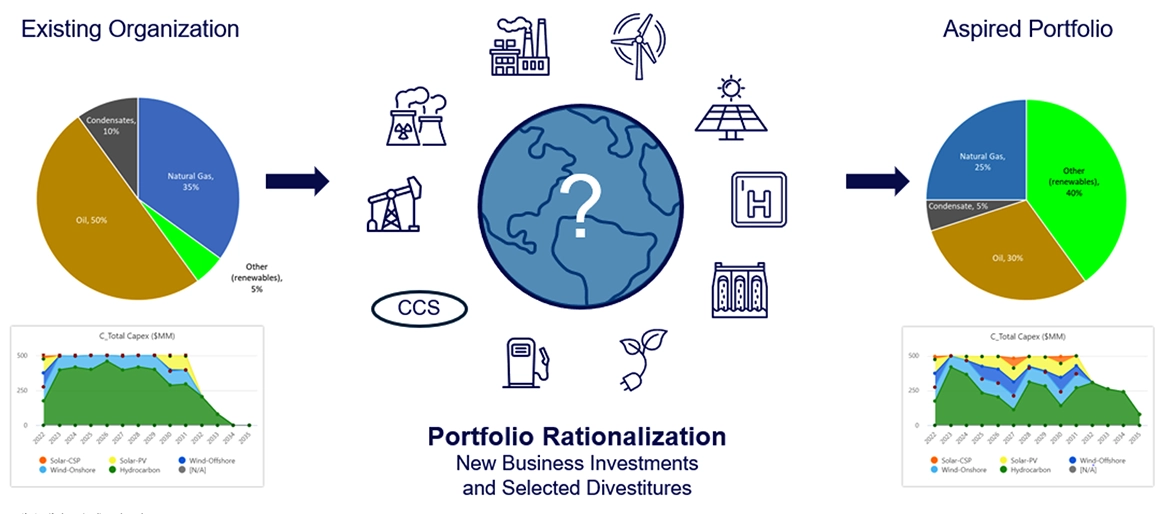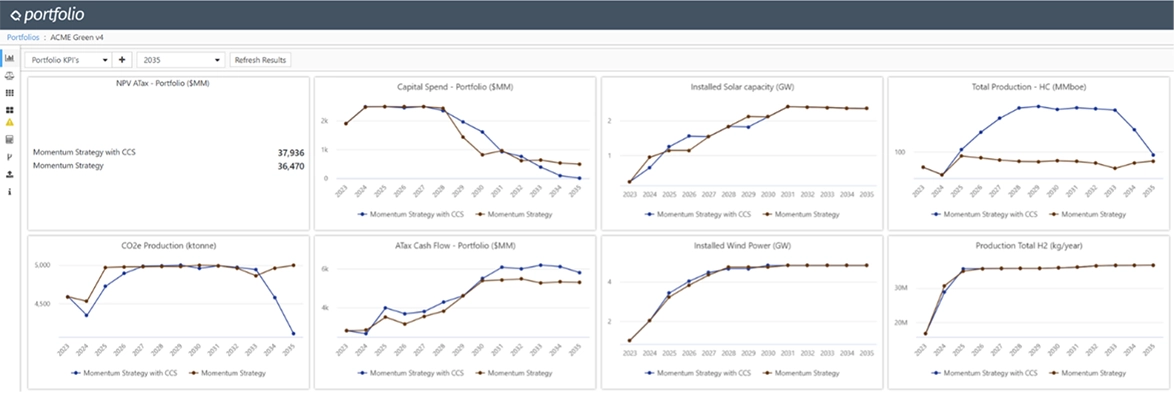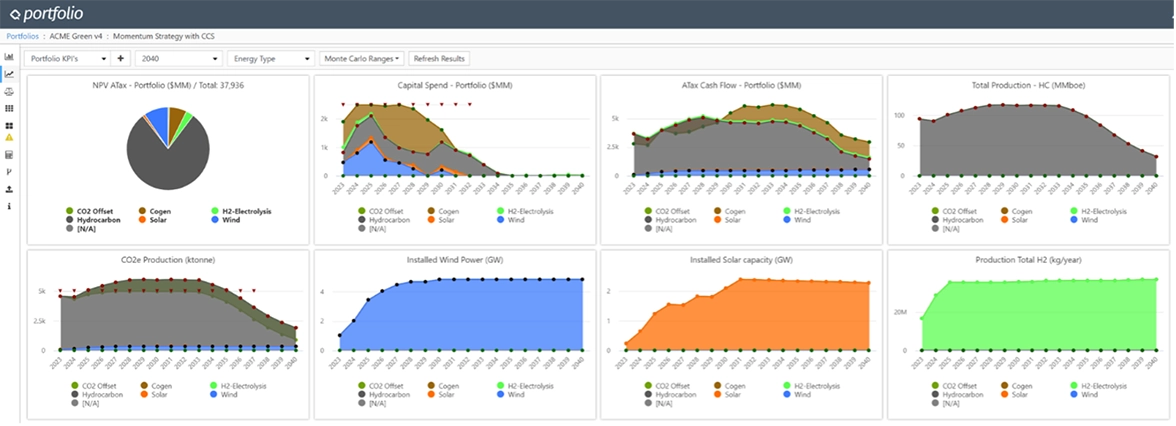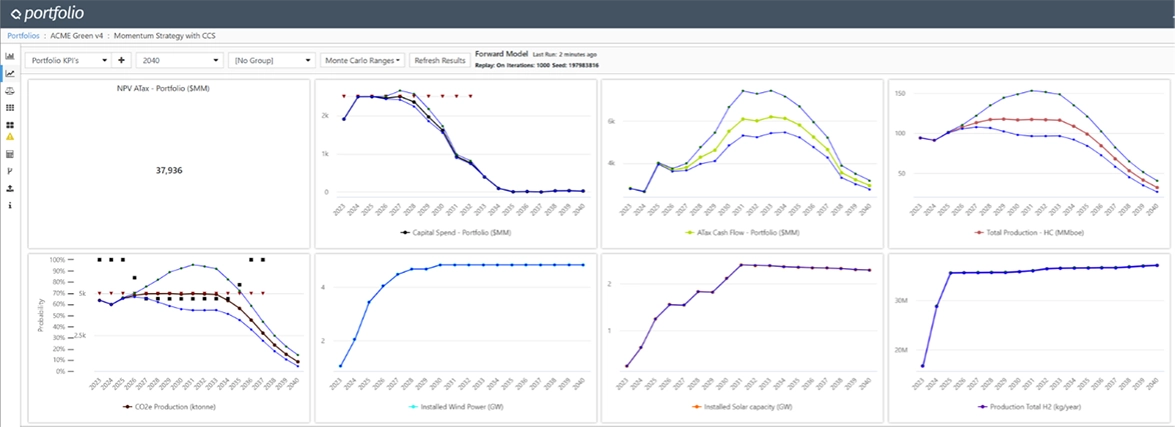The Valuation of Carbon Sequestration Using Portfolio Modeling
Here’s a fact: the Energy Transitions Commission estimates the total cost of the global clean energy transition is $110 trillion in capital investments over the course of 30 years. That’s an incredibly large chunk of change, one that relies on numerous industries and regulatory bodies to take place.
Here’s another fact: much of that cost will be offset by the financial benefits of the strategic energy transition, and the companies who realize that will be set up for long-term success.
The energy transition has often been discussed in terms of its cost, causing companies to debate how many projects they want to take on. However, there’s often value associated with projects that have a loss or cost. For example, while there’s a cost for reducing your organization’s carbon footprint, there is downstream positive value when you’re trying to achieve multiple objectives at the same time.
This was the subject of a recent presentation I gave at GSEU Day in Brussels for a group of professionals committed to a sustainable Geological Service for Europe. At Quorum, we wanted to showcase the positive financial value of projects associated with the energy transition, which is the driving force behind our carbon sequestration portfolio modeling platform.
Below I’ve broken down the seven simple steps you can take with Quorum’s Strategy & Portfolio Software to provide a holistic view of your company’s investments in the energy transition and determine the ideal asset mix.
1. Quantify specific objectives
It may seem trivial, but it’s critically important to be explicit in defining your company objectives. You have to know what you want in order to achieve it, which is why a model that forces you to be explicit in your goals is key.
Typically, this will consist of a marriage between financial and operational objectives, such as increasing earnings, growing production and lowering the carbon footprint by a certain amount. It’s common for companies, even supermajors, to have a lack of clarity internally. Communicating business priorities across the company aligns all employees on a common set of goals, setting the stage for success.
2. Characterize the inventory
Once your goals are defined, it’s time to review your company’s existing inventory as well as look at a wider variety of potential investments. Aside from typical investments in oil and gas, this includes looking at wind, solar and carbon sequestration projects to determine how these assets can either be expanded or developed.
The greatest value in this step of the process is that the option space always increases. If your company has historically avoided investments in renewables or expanding natural gas, this step forces your team to review all options to understand their potential value.

3. Specify the optionality or dependency
Once you’ve determined new investments and potential expansions in step two, it’s time to make them more realistic. When are these investments available? How scalable are they for your company’s operation? Modelling new investments within a Strategy & Portfolio management application helps investors to clarify and test their assumptions, gaining insights into project dependencies and constraints that might otherwise be missed.
If your company is planning to invest in clean hydrogen, for example, it’s important to determine the smallest amount of investment that would provide a return, the critical early investments, and the large future capital outlays potentially needed.
4. Optimize the portfolio composition
There is no such thing as an ‘optimal portfolio’ because every investment is a trade-off between growing earnings in the near term and reducing carbon footprint in the long term. The key is to make educated trade-offs based on the insights your team has gathered on the costs versus the benefits.
With our software, your team can generate multiple scenarios in a matter of moments to determine which is the most effective to meet your priority business goals. This can include target carbon reduction as well as capital expenditures to determine how you’re going to achieve the delicate balance needed for success.
5. Compare and contrast multiple scenarios
Once you’ve run several scenarios, it’s time to review the benefits and trade-offs of each. For example, when determining the timing of carbon reduction strategies, deciding between 2030 and 2035 for your target date can have wide-ranging ramifications across the business. Investing too rapidly causes existing assets to degrade, but moving slowly could force you to miss your ideal window of clean energy development. Quorum allows you to review the constraints and value of each scenario over time with easy-to-read charts, including CO2 production, installed wind power, cash flow and more.
Once you’ve identified the scenario that best fits your business objectives, it’s time to dive deeper into the specifics.

6. Distill scenario results for further insights
There are so many complexities in designing an energy portfolio, and this step breaks down the plan to figure out how to navigate them. Stakeholders should break down the plan by region, asset type, business unit and more to determine the portfolio’s impact on every aspect of the business.
This step also allows the executive leadership team to better execute the strategy by completely tearing it apart. To execute a plan, you need to fully understand the plan – so make sure you’re nitpicking each detail!

7. Monte Carlo simulations
So now you’ve settled on a strategy, dug into the numbers and identified the greatest opportunities for your business. There’s just one problem: every element has an uncertain amount of financial benefit, so you can never be 100% certain of how it will shake out.
Monte Carlo simulations allow you to look at outcomes from different simulations of your proposed portfolio. Quorum’s Strategy & Portfolio Software can run this simulation on the entire portfolio to determine an aggregate probability, which is perhaps the greatest value added of the platform.
Rather than creating business plans with 50/50 uncertainty, this final step provides much higher confidence that your strategy will achieve the desired goal.

Carbon sequestration is a rapidly growing tool for energy companies that will have major impacts on how businesses solve the issue of carbon reduction. Weaving this into conventional energy portfolios is going to solve some major challenges associated with the energy transition in the year ahead, and there’s no better time to take a look at how it can benefit your business than right now!
I was thrilled to share my experiences with the attendees at GSEU Day and hope this has been a helpful primer to think about carbon reduction strategies. To learn more about how our Strategy & Portfolio Software can help your business along the path to a profitable net zero future, visit the website here.

 Previous Page
Previous Page